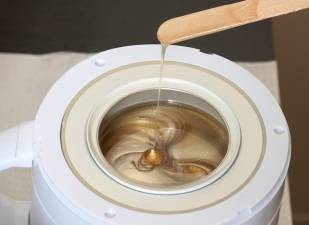Have your pearly whites lost their luster because of dingy gray or yellow stains? Stained teeth can occur as we age, but some common foods, drinks, and even mouthwashes can stain teeth. Do-it-yourself remedies can help whiten teeth, and avoiding substances that stain teeth can stop further discoloration. Use these secrets to whiter teeth to restore your bright smile.
 Home Remedies for whitening teeth:
Home Remedies for whitening teeth:
Make a paste by mixing
2 teaspoons of hydrogen peroxide
2 teaspoons of baking soda.
Place the mixture in a small bowl. The thickness of the paste should be consistent as the typical thickness of toothpaste. For a beter taste, add a bit of mint or just a scoop of toothpaste can be combined with the home-made paste for whitening teeth.
Now, how is this home-made whitening theeth remedy re used?
Apply with a toothbrush and leave the mixture on your teeth for at a couple of minutes. You should avoid swallowing the paste. If this happens, just drink lots of water. Use only once or twice a week.
Home Remedies for whitening teeth #1: Brush my teeth really with regular tooth paste. Then pour some extra virgin olive oil on a white wash cloth and scrub your teeth for incredible results
Home Remedies for whitening teeth #2: Make a paste of few drops of lemon juice and a pinch of common baking soda. Apply this to your teeth and massage gently as if brushing. This helps to remove the stain from the teeth.
Home Remedies for whitening teeth #3: Rub your teeth with the inside of orange peels. Orange peels have a mild compound that has been shown to whiten teeth which removes stains from teeth without damaging the enamel.
IMPORTANT: While hydrogen peroxide is safe to gargle and to use as a home remedy to whitening teeth, one should be extra careful not to swallow any of it as it poses a health hazard to the body. For pregnant or lactating women, any accidental swallowing of the whitening gel could be potentially harmful to the unborn fetus.
When using hydrogen peroxide, you may also experience gum irritation. This is perfectly normal and natural however you should avoid using it if you have any sores inside your mouth.
 Home Remedies for whitening teeth:
Home Remedies for whitening teeth:Make a paste by mixing
2 teaspoons of hydrogen peroxide
2 teaspoons of baking soda.
Place the mixture in a small bowl. The thickness of the paste should be consistent as the typical thickness of toothpaste. For a beter taste, add a bit of mint or just a scoop of toothpaste can be combined with the home-made paste for whitening teeth.
Now, how is this home-made whitening theeth remedy re used?
Apply with a toothbrush and leave the mixture on your teeth for at a couple of minutes. You should avoid swallowing the paste. If this happens, just drink lots of water. Use only once or twice a week.
Home Remedies for whitening teeth #1: Brush my teeth really with regular tooth paste. Then pour some extra virgin olive oil on a white wash cloth and scrub your teeth for incredible results
Home Remedies for whitening teeth #2: Make a paste of few drops of lemon juice and a pinch of common baking soda. Apply this to your teeth and massage gently as if brushing. This helps to remove the stain from the teeth.
Home Remedies for whitening teeth #3: Rub your teeth with the inside of orange peels. Orange peels have a mild compound that has been shown to whiten teeth which removes stains from teeth without damaging the enamel.
IMPORTANT: While hydrogen peroxide is safe to gargle and to use as a home remedy to whitening teeth, one should be extra careful not to swallow any of it as it poses a health hazard to the body. For pregnant or lactating women, any accidental swallowing of the whitening gel could be potentially harmful to the unborn fetus.
When using hydrogen peroxide, you may also experience gum irritation. This is perfectly normal and natural however you should avoid using it if you have any sores inside your mouth.










